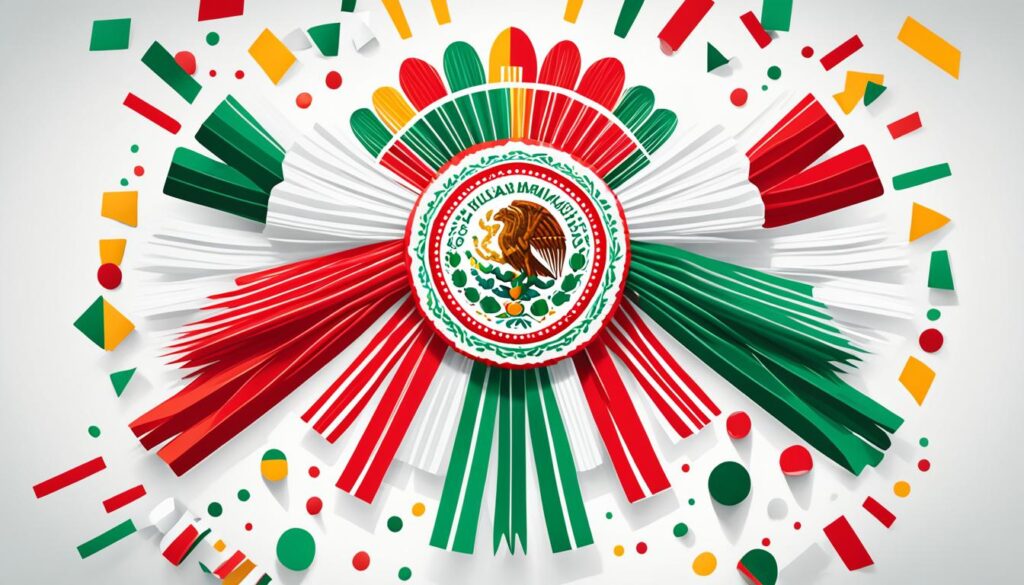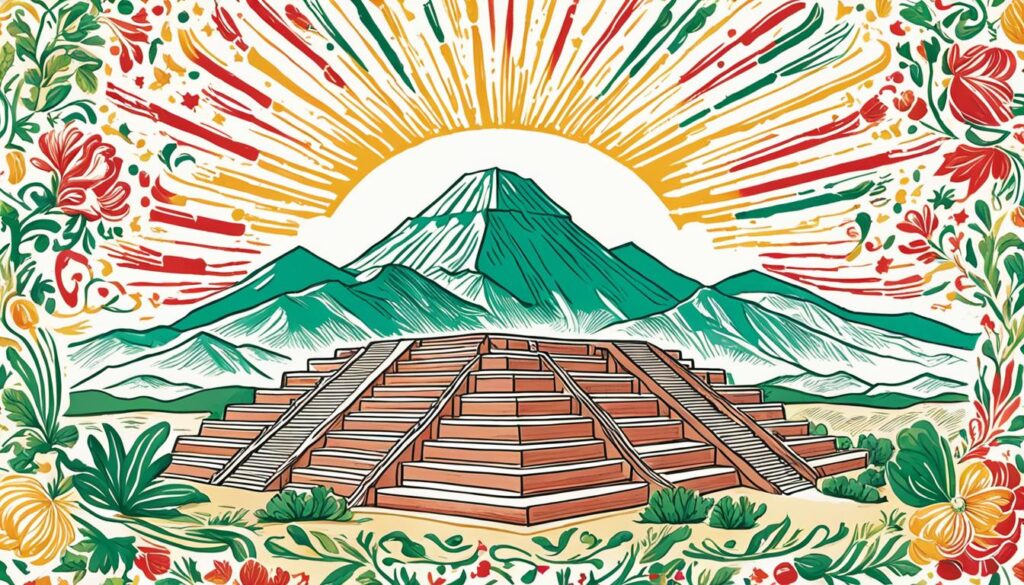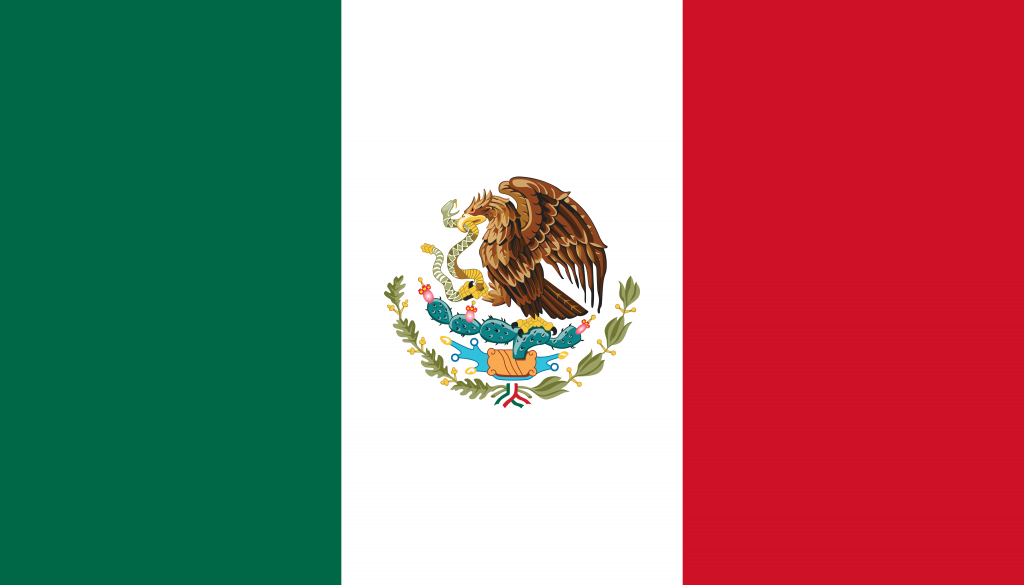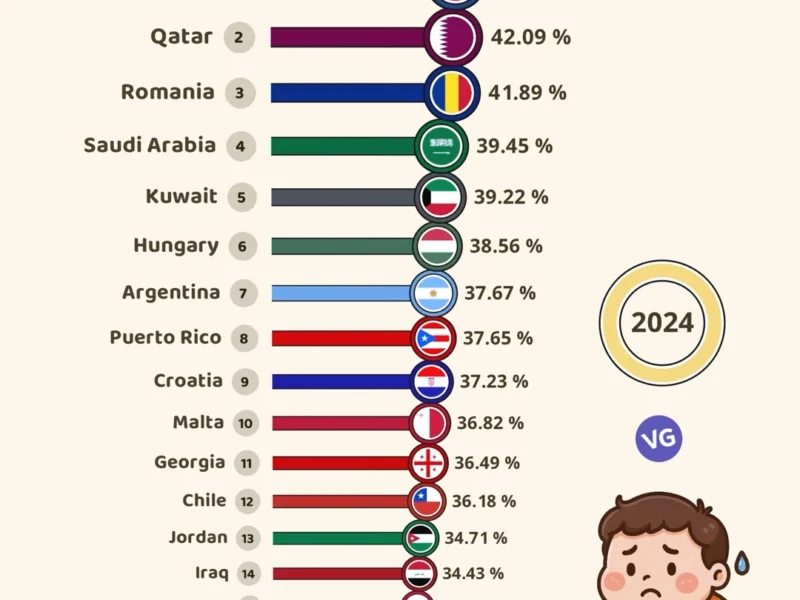The national flag of Mexico is called the Bandera de México. It is a tricolor flag with green, white, and red bars. The Mexican coat of arms sits in the middle of the white stripe.1 This flag is a strong symbol of national pride and heritage. Its history goes back to Mexico’s independence from Spain.2 The design and colors of the flag carry special meanings. They stand for the nation’s core values and identity.
Key Takeaways:
- The Mexican flag was officially adopted on September 16th, 1968.2
- It shows three colors: green, white, and red. They mean hope, unity, and tribute to heroes, in that order.1
- A Golden Eagle is at the flag’s center. It represents courage, power, and the Mexican people’s strong spirit.1
- The colors of the Mexican flag are not just on the flag. They are also key in Mexican food, clothing, and culture.1
- The Mexican flag is deeply loved and honors Mexican identity. It reflects pride, strength, and cultural meaning for Mexico.1
Introduction
National flags are strong symbols. They show a country’s identity, history, and values. A Mexican flag is very important to Mexico. It represents Mexican history and who they are today.3
The Significance of National Flags
National flags show what makes each country unique. They are a way to show a country’s culture, values, and hopes. Flags help people feel like they belong and are part of something big, together.4
The Mexican Flag: A Representation of History and Identity
The Mexican flag tells a lot about the country’s past. It is a picture of Mexico’s cultural identity. The design and colors of the flag have changed with Mexico’s history. This includes gaining independence from Spain and becoming the Mexico we know today.3
The Origins and Evolution of the
Before Mexico chose its national flag, several flags flew during the4 war for independence from Spain. The3 first widely recognized Mexican flag was the Standard of the Virgin of Guadalupe. Miguel Hidalgo carried it after issuing the Grito de Dolores on September 16, 1810. This flag marked the beginning of the rebel forces’ fight.
The First Mexican Flag: The Standard of the Virgin of Guadalupe
Different groups in the4 Mexican War of Independence used their own flags. José María Morelos flew a flag with the Virgin’s image. It included a crowned eagle on a cactus over a bridge with the letters V.V.M. (Viva la Virgen María – “long live the Virgin Mary”). The Revolutionary Army had a flag with white, blue, and red stripes.
The Flags of the Mexican War of Independence
After winning freedom from Spain, Mexico adopted new colors for its flag: green, white, and red. This change happened in the flag of the Army of the Three Guarantees. In1 1821, an official decree declared these as the national colors. It also stated that the flag would have a crowned eagle in the middle.
The Establishment of the Tricolor: Green, White, and Red
The Symbolism Behind the Colors and Design
The Mexican flag is filled with bright colors and a strong design. It symbolizes Mexico’s rich history, values, and culture. The flag uses green, white, and red colors. These stand for Mexico’s national identity, strength, and pride. They have always been important to Mexico.1
Green: Independence and Hope
Green on the flag shows Mexico’s independence and hope.1 After Mexico broke free from Spain, green became a national color. It shows Mexico’s new freedom and dreams for the future.1
White: Purity and the Catholic Faith
White in the flag means purity and faith in the Catholic Church.5 It was added to the flag design for this reason. It shows how important the Catholic faith is in Mexico. It also shows the nation’s pure ideals.5
Red: Union and the Blood of National Heroes
Red represents unity and the heroes of Mexico.5 It stands for the union of the Mexican people. It also honors the blood spilled by those who fought for freedom.5

The Coat of Arms: The Eagle, the Serpent, and the Cactus
The coat of arms on the Mexican flag is key, showing an eagle eating a snake on a cactus. This design stands for the Aztec story of founding their capital, Tenochtitlán, now Mexico City. In this myth, the Aztecs built their city where they saw this eagle scene. That’s why it’s on the6 Mexican coat of arms.
The Foundation Myth of Tenochtitlán
The story goes that the Aztecs were told to build their city when they found an eagle with a snake on a cactus. This place happened to be a lake with a nopal (cactus) on a rock. This moment is very important and explains the use of the7 eagle, serpent, and cactus in Mexico’s symbols.
The Artistic Renditions and Adaptations
The look of the7 Mexican coat of arms has changed with time, showing the country’s changes. First, it had a crowned eagle during the Mexican Empire. Now, it includes a wreath of oak and laurel. The eagle, serpent, and cactus design always stayed. This shows it’s a strong symbol of7 Mexican identity.
The Mexican Flag and National Identity
The Mexican flag is a strong symbol uniting the country and showing pride.1 With its tricolor design and special coat of arms, it deeply connects to Mexico’s heart.8 It’s seen a lot during special times like national holidays, official events, and sport matches. This use reminds people how they’re part of something big.
A Symbol of Unity and Patriotism
The Mexican flag is key in celebrating the country.1 People often see it flying high on days like Independence Day. At events like parades and community gatherings, its image is strong and clear.8 These moments bring Mexicans together, reminding them of their common past, values, and love for their homeland.
The Flag’s Role in Celebrations and Ceremonies
18 The flag is really important during national events. It shows the strong connection to mexican patriotism, celebrations, and ceremonies. Its presence everywhere unites Mexicans and helps them remember their shared culture and history.

Flag Etiquette and Proper Display
The Mexican flag must be shown and handled carefully, following mexican flag etiquette. These rules help us treat the flag with respect. They tell us where to put the flag, how to carry it, and how to get rid of it properly. Following these rules keeps the mexican flag display meaningful and honorable.9
On February 24, Mexico honors its flag. This tradition started in 1935, celebrating the Plan de Iguala. During public events, people must greet the Mexican flag in a special way. All schools in the country, no matter if they’re public or private, must have a Mexican flag. They also must do flag ceremonies.9 Flags at places like the Congress building, immigration offices, and consulates must be up every day.9
By law, people can burn the Mexican flag to show their thoughts freely.9 But, everyone should treat the flag with respect. The mexican flag display is a big part of Mexico’s identity. Following these rules shows that we value what the flag stands for.
The Mexican flag’s emblem shows an eagle with a snake on a cactus.9 Yet, some experts wonder if the eagle is a different kind.9
The Coat of Arms on the Mexican flag must keep the same place when it’s raised, as stated by law.10 For decorative flags, the Coat of Arms’ size might change. It can be from three-fourths the white stripe’s width to half the flag’s width.10 Decorative, vertical flags with different shapes are often used in September’s Independence Day and November’s “Revolución Mexicana.” People hang them on posts, lights, and around their homes for celebrations.10

The Mexican Flag in Art, Literature, and Popular Culture
Artistic Interpretations and Representations
Throughout Mexico’s history, the mexican flag has inspired artists and writers. Its colorful design and deep meaning show in paintings, sculptures, poems, and songs. These artworks celebrate Mexican identity, making the flag a cherished symbol.
Literary Works and Poetic Expressions
Poets and authors in Mexico have often written about the mexican flag. They use its symbols to talk about love for their country and what it means to be Mexican. Their work helps keep the flag important in Mexico’s art and culture.11
The Global Influence of the Mexican Flag
The Mexican flag is more than just a national symbol. It’s known worldwide, representing Mexican culture.1 Its bright colors and unique design stand out, making it a quick way to show Mexico.1 Thanks to this, the flag does a big job as a cultural ambassador. It helps share Mexico’s heritage and identity with everyone.1
Recognizable Symbol of Mexican Culture
The Mexican flag’s looks have even inspired other countries’ flags.12 Many nations use a similar three-color scheme and meaningful images. This shows the Mexican flag has a lasting global impact.12 Even though the details may vary, you can spot Mexico’s influence in flags across the world.
Inspiration for Other National Flags
The Mexican flag’s design is well-known everywhere for its lively colors.1 Its influence makes it a strong representative of Mexican culture. It showcases Mexico’s heritage all around the world.1 Plus, this design has helped shape flags of many other countries. It proves the Mexican flag’s lasting effect globally.12
Controversies and Debates Surrounding the Flag
The Mexican flag is a key national symbol but it’s not without its controversies. People talk about changing parts of the flag like its colors or coat of arms. These talks make Mexicans really emotional because the flag means so much to them.
Proposed Changes and Modifications
The Mexican government and people work hard to keep the flag special. Laws guide how the flag should be treated. This keeps the flag’s meaning strong and protects it from being used in the wrong way.
Protecting the Flag’s Integrity
13 Mexican flags in the U.S. can cause both good feelings and debates about issues like immigration.14 Fans show their support during the World Cup, which could mean seeing more Mexican flags around. It’s very important to take good care of the Mexican flag. It stands for the country’s heritage and spirit.
Conclusion
The Mexican flag is a symbol of history, values, and identity.1 It was born in the War of Independence and still shines today. Its colors and design make Mexicans proud, uniting them in spirit.
This icon became official on September 16, 1968,1 and is honored on February 24th each year.1 With its green, white, and red parts,115 and the emblem of the eagle, it stands for hope, victory, and unity. It remembers Mexican heroes, shaping the nation’s soul.
The Mexican flag is deeply loved,1 highlighting the nation’s pride and spirit.1 Its design and meaning are known worldwide.115 They ensure it reflects Mexico’s heart and stays a strong symbol for its people and others worldwide.
FAQ
What is the national flag of Mexico?
The national flag of Mexico is the Bandera de México. It is a tricolor with green, white, and red stripes. The Mexican coat of arms is in the center of the white stripe.
What do the colors of the Mexican flag represent?
Green stands for independence and hope. White means purity and the Catholic faith. Red symbolizes the unity of the Mexican people and their heroes’ blood in the fight for independence.
What is the significance of the coat of arms on the Mexican flag?
The coat of arms is the flag’s central emblem. It shows an eagle eating a snake on a cactus. This design comes from the Aztec city of Tenochtitlán, which is now Mexico City.
How does the Mexican flag serve as a symbol of national unity and patriotism?
The Mexican flag’s design and coat of arms are key symbols for Mexicans. They foster pride and a sense of belonging. The flag is highly visible during national events. It brings Mexicans together as a nation.
How is the display and handling of the Mexican flag governed?
There are specific rules called flag etiquette for how to display and handle the Mexican flag. These rules cover the flag’s care and show the respect due to it.
How has the Mexican flag influenced other national flags?
The Mexican flag has inspired the design of flags in other countries. Its tricolor and symbolic images have been used by various nations. This shows the Mexican flag’s global impact and popularity.
Have there been any controversies or debates surrounding the Mexican flag?
The Mexican flag has sometimes been at the center of debates due to its design and meanings. Some people have suggested changing parts of it. These discussions are very passionate, with many defending the flag’s original design and importance.
Source Links
- https://www.barcelo.com/pinandtravel/en/mexican-flag/
- https://charroazteca.com/blogs/blog/the-history-and-beauty-of-the-mexican-flag-a-symbol-of-national-pride
- https://lolomercadito.com/blogs/news/the-mexican-flag-history-origin-and-symbolism
- https://en.wikipedia.org/wiki/Flag_of_Mexico
- https://www.worldatlas.com/articles/what-do-the-colors-and-symbols-of-the-flag-of-mexico-mean.html
- https://embamex.sre.gob.mx/reinounido/images/stories/PDF/Meet_Mexico/2_meetmexico-symbolsofmexico.pdf
- https://en.wikipedia.org/wiki/Coat_of_arms_of_Mexico
- https://flagladyusa.com/blogs/blog/unveiling-the-rich-heritage-behind-the-mexico-flag
- https://theguadalajarareporter.net/index.php/featured/49677-nine-things-you-probably-didn-t-know-about-mexico-s-flag
- https://www.crwflags.com/fotw/flags/mx_v.html
- https://www.history.com/topics/latin-america/history-of-mexico
- https://theculturetrip.com/north-america/mexico/articles/the-story-behind-the-mexican-flag
- https://www.latimes.com/archives/la-xpm-2006-mar-29-me-flag29-story.html
- https://cronicas.latinostudies.duke.edu/the-world-cup-is-coming-u-s-wont-be-there-mexico-will-get-ready-for-a-mexican-flag-controversy/
- https://unacademy.com/content/upsc/study-material/general-awareness/flag-of-mexico/


